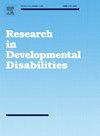Auditory social cognition precursors in 12-month-old infants with visual impairment: A preliminary study
IF 2.6
2区 医学
Q1 EDUCATION, SPECIAL
引用次数: 0
Abstract
Background and aim
Clinical observations have long suggested that infants with visual impairment (VI) may experience delays in the development of socio-cognitive skills compared to their fully-sighted (FS) counterparts. Nonetheless, evidence supporting anecdotical observations remains limited. In this study, we assessed socio-cognitive behaviours in a cohort of infants with VI and compared them to a group of FS infants between 9 and 12 months of age.
Methods
Our analysis focused on key early markers of social and cognitive engagement, including gaze orienting, communicative signalling, and interaction patterns with the environment and caregivers.
Results
Gaze orienting and the production of basic communication signals, such as vocalizations and gestures aimed at initiating social interaction, were largely comparable between the VI and FS groups. However, important differences emerged in more complex socio-cognitive behaviours: infants with VI exhibited significantly less triangulation and produced fewer pointing gestures compared to FS infants.
Conclusions
These findings highlight specific socio-cognitive vulnerabilities in early development associated with visual impairment and underscore the need for targeted early interventions.
What this paper adds
This study explores the early emergence of socio-cognitive developmental precursors in a sample of 9- to 12-month-old infants with visual impairments, compared to their fully sighted counterparts. The results indicate that specific socio-cognitive vulnerabilities may be observable as early as the end of the first year of life in infants with visual impairments, who demonstrated less triangulation abilities and produced fewer pointing gestures than full-sighted peers. We suggest that these findings could help refine early intervention strategies for this population.
视觉障碍12个月婴儿听觉社会认知前体的初步研究。
背景和目的:长期以来的临床观察表明,与视力正常(FS)的婴儿相比,视力障碍(VI)婴儿在社会认知技能发展方面可能会出现延迟。尽管如此,支持轶事观察的证据仍然有限。在这项研究中,我们评估了一组患有VI的婴儿的社会认知行为,并将他们与一组9至12个月大的FS婴儿进行了比较。方法:我们的分析侧重于社交和认知参与的关键早期标志,包括凝视定向、沟通信号以及与环境和照顾者的互动模式。结果:注视方向和基本交流信号的产生,如旨在发起社会互动的发声和手势,在VI组和FS组之间基本相似。然而,在更复杂的社会认知行为中出现了重要的差异:与FS婴儿相比,VI婴儿表现出更少的三角化和更少的指向手势。结论:这些发现强调了与视力障碍相关的早期发育中特定的社会认知脆弱性,并强调了有针对性的早期干预的必要性。这篇论文补充了什么:这项研究在9到12个月大的有视力障碍的婴儿样本中探索了社会认知发展前体的早期出现,并与他们完全视力的同龄人进行了比较。研究结果表明,特定的社会认知缺陷可能早在出生一年后就可以在视力受损的婴儿身上观察到,这些婴儿比视力正常的同龄人表现出更少的三角定位能力和更少的指向手势。我们认为这些发现可以帮助完善这一人群的早期干预策略。
本文章由计算机程序翻译,如有差异,请以英文原文为准。
求助全文
约1分钟内获得全文
求助全文
来源期刊

Research in Developmental Disabilities
Multiple-
CiteScore
5.50
自引率
6.50%
发文量
178
期刊介绍:
Research In Developmental Disabilities is aimed at publishing original research of an interdisciplinary nature that has a direct bearing on the remediation of problems associated with developmental disabilities. Manuscripts will be solicited throughout the world. Articles will be primarily empirical studies, although an occasional position paper or review will be accepted. The aim of the journal will be to publish articles on all aspects of research with the developmentally disabled, with any methodologically sound approach being acceptable.
 求助内容:
求助内容: 应助结果提醒方式:
应助结果提醒方式:


